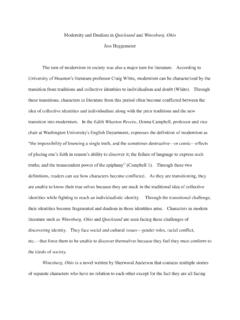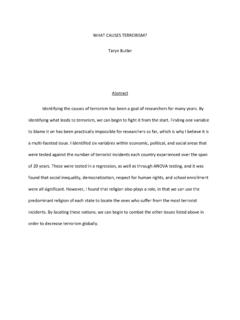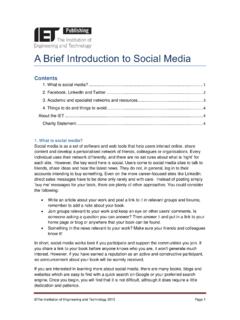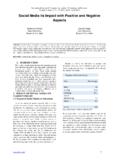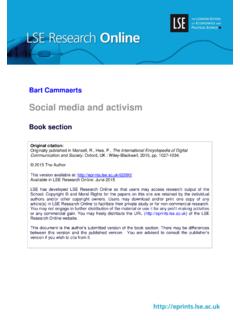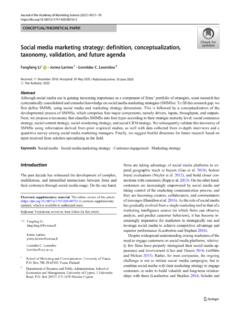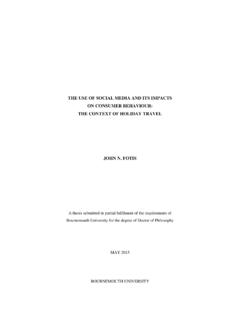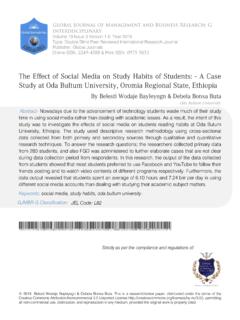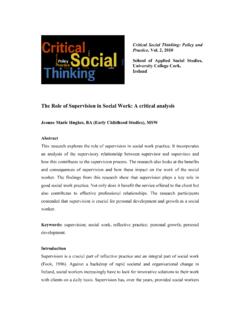Transcription of The effect of social media use on narcissistic behavior ...
1 The effect of social media use on narcissistic behavior Tiffany A. Somerville Abstract social media use has grown exponentially in recent years, especially amongst adolescents and young adults (Pew Research Center, 2014). Several studies have shown that social networking does indeed have an effect on self-esteem. This study posited that those who use social media more often are more likely to exhibit narcissistic behavior . The author conducted a survey of 100 students from a private, Midwestern university. The results indicated that time spent on social media does indeed increase narcissistic behavior . Keywords: social media , narcissism, self-esteem For many people, social media is an integral part of their daily entertainment and connection to others.
2 The invention of smartphones and tablets has allowed Internet users to have access to their social networks in almost any location. Several statistics reveal the enormous numbers of people who are active on social media : As of January 2014, 74% of adults who use the Internet use social media websites (Pew Research Center, 2014). Online adults aged 18-29 are the most active age group with 89% using social networking sites (Pew Research Center, 2014). 71% of adults who use the Internet are members of Facebook (Pew Research Center, 2014). 40% of cell phone users access a social networking site on their phone (Pew Research Center, 2014). Facebook has billion monthly active users (Sedghi, 2014).
3 Because social media is so prevalent, psychologists are often interested in how this relatively new form of interaction affects psychological and emotional elements such as self-esteem. First, it is helpful to define the terms social media or social networking, to define elements of narcissism, and to describe the interaction between the former and the latter. Definitions of social media /Networking social networking sites can be defined as web-based services that allow individuals to (1). construct a public or semi-public profile within a bounded system, (2) articulate a list of other users with whom they share a connection, and (3) view and traverse their list of connections and those made by others within the system (Boyd & Ellison, 2007, p.)
4 212). social network sites generally have people create a profile and interact with others, typically friends that one already knows outside of the Internet. The earliest social network sites were launched in the late 1990s, but these types of sites did not become a worldwide phenomenon until around 2003 with the launch of sites like Friendster and MySpace (Boyd & Ellison, 2007). More recently, social media sites have evolved from simple profile creation and interaction to means of micro- blogging Twitter has 145 million users that send 90 million tweets per day (Kietzmann, Hermkens, McCarthy, & Silvestre, 2011). With billion monthly users, Facebook certainly reigns as the most popular site worldwide (Sedghi, 2014).
5 Because social media is used as a general term to describe any site or smartphone application that allows its users to interact with others, the actual types of social networking sites are quite varied. Young adults are the most frequent users of such sites, and their activity is spread amongst several sites: Source: The Atlantic, 2014. Definition of Narcissism The term narcissism has its origins in the Greek myth of Narcissus, a man who refused all lovers and was cursed by the gods to fall in love with his own reflection (Konrath, 2007). Narcissism as a psychological affliction has its roots in Freudian psychoanalysis, though the evolution of the condition has led to the inclusion of narcissistic personality disorder in the DSM.
6 (Konrath, 2007). The DSM-5 criteria for diagnosis of narcissistic personality disorder requires significant impairment in personality and interpersonal functioning as well as several pathological traits that indicate that the subject is grandiose, superficial, and attention-seeking (American Psychological Association, 2014). Persons who exhibit some elements of any of the three criteria can be said to be experiencing narcissistic behavior without meeting all of the requirements for a personality disorder (Skodol, Bender, & Morey, 2014). narcissistic personality disorder has two subtypes: vulnerable and grandiose. Grandiose narcissists typically experience more dramatic traits that are similar to histrionic personality disorder and they do not report much interpersonal distress (Dickinson & Pincus, 2003).
7 Vulnerable narcissists, however, rate more highly on traits related to avoidant personality disorder, and they often experience more interpersonal distress due to their vindictive behavior (Dickinson & Pincus, 2003). Developmental Theories of Narcissism narcissistic personality disorder is not well-understood, and its etiology is still largely a matter of speculation. Some psychologists theorize that the condition stems from childhood developmental factors (Groopman & Cooper, 2006). Children who were overindulged by parents, given too much admiration without criticism, or abused emotionally have been found to be more likely to experience narcissistic behavior (Groopman & Cooper, 2006).
8 The dynamic self-regulatory processing model postulates that people with narcissism use an ongoing process instead of simply possessing an unchanging condition; their personality functions around maintaining and enhancing their grandiose sense of self-worth (Thomas, Bushman, Castro, and Stegge, 2009). Their actions and self-perceptions on both an interpersonal and intrapersonal level are actively created to perpetuate their maladaptive condition (Thomas, Bushman, Castro, and Stegge, 2009). narcissistic personality disorder has also been conceptualized as an inherent need for validation that turns into pathological thoughts and behaviors (Wright, 2014). Measurement of Narcissism Researchers have created and validated several published measures of narcissism.
9 The first measure to accurately study narcissistic behavior was the narcissistic Personality Inventory that was released in the 1970s (Emmons, 1987). Many of the most commonly used tests are self- report measures, such as the Five-Factor Narcissism Inventory (FFNI), the Pathological Narcissism Inventory (PNI), narcissistic Personality Inventory (NPI), and the Hypersensitive Narcissism Scale (HSNS); some of them focus more on grandiose traits while others focus on vulnerable traits (Miller, McCain, Lynam, Few, Gentile, MacKillop, & Campbell, 2014). The Hypersensitive Narcissism Scale has been found to be one of the most accurate measures of vulnerable narcissism (Miller et al.)
10 , 2014). Increases in Narcissism narcissistic personality disorder is actually a relatively prevalent condition with one study finding that of females and of males meet the criteria which is quite high for a personality disorder (Paris, 2014). Even since the 1970s, some psychologists have argued that modern culture continually increases levels of narcissism (Emmons, 1987). Many psychologists argue that modern cultural factors have increased the prevalence of narcissistic personality disorder. One study found that college students in 2009 had higher scores on the narcissistic Personality Inventory than students from 30 years prior (Paris, 2014). Several studies have shown that teenagers and middle school students have much higher self-esteem and career aspirations than members of their age group in the past few decades (Twenge, Miller, &.
